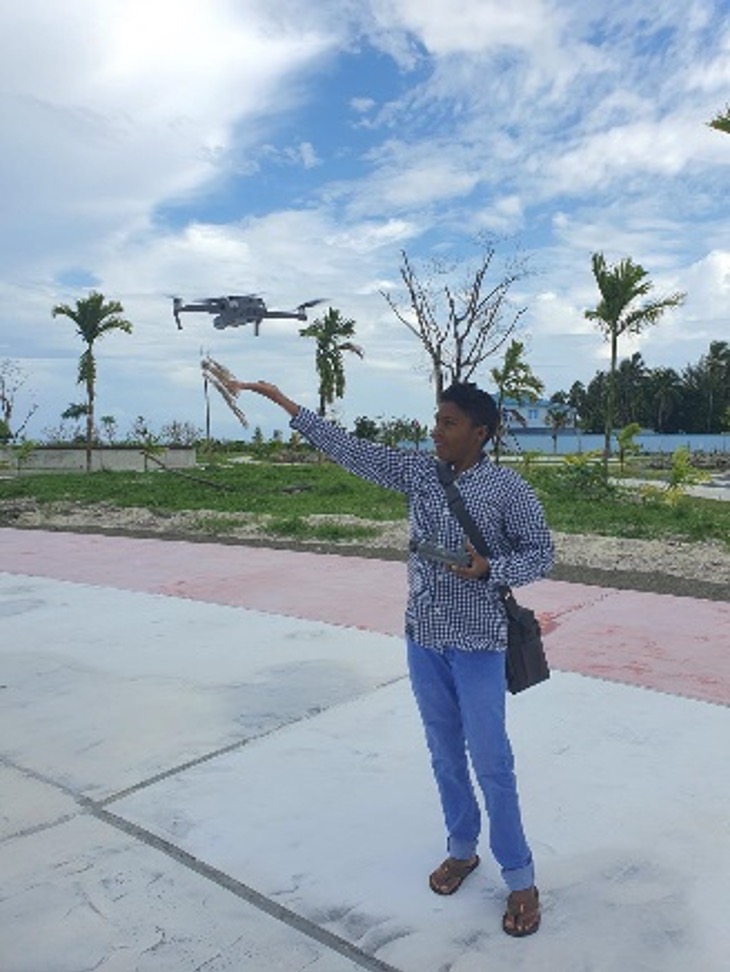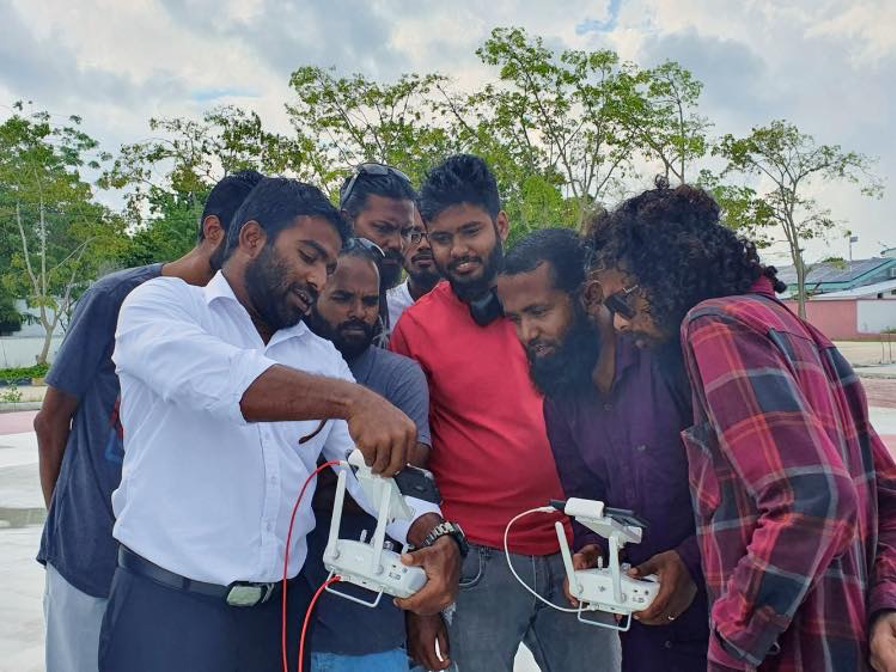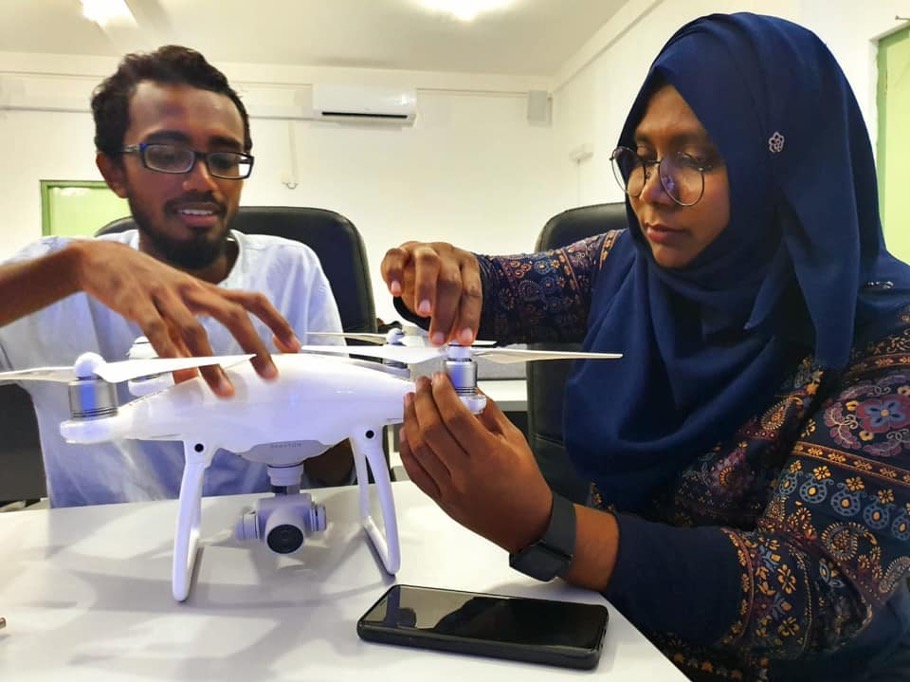 Drones for Resilience
Scaling up national capacity for disaster risk reduction and management in Maldives
Drones for Resilience
Scaling up national capacity for disaster risk reduction and management in Maldives

Challenges
Formed by a chain of 1,200 islands in the Indian Ocean and home to nearly 400,000 people, Maldives is the lowest-lying country in the world. Most of the islands are threatened by climate change; 80 percent are only one metre above sea level. Maldives, and many other island nations around the world, could soon disappear without urgent action. Shorelines are already changing rapidly, and scientists predict that rising sea levels will submerge most of the islands by 2050.
Maldives also faces a constant risk of being impacted by natural events, such as tropical cyclones, storms, thunderstorms, drought, flooding from heavy rainfall, storm surges, swell waves and tsunamis. The islands also face climate-related hazards, such as changes in monsoon patterns and rising sea levels and surface temperatures. The consequences of these events are visible, and locals are already feeling their effects.
Towards a Solution
The ‘Drones for Resilience’ project, a public-private partnership between Dhiraagu Plc (a Maldivian telecommunications company) and the United Nations Development Programme (UNDP) Maldives, aims to promote the use of drone technology for community-based disaster resilience planning in Maldives.
The project focuses on incorporating drones to create detailed, real-time maps of four islands to be used in disaster risk assessment. The collected data improve local authorities' capacity for disaster preparedness and disaster risk management. The maps are also used by local and national officials for land-use planning and to identify high-risk areas and safe zones within the islands.
The project’s objective is to improve the capacity of Addu City, in southern Maldives, to undertake risk-informed planning and develop evidence-based climate action plans. While data are a prerequisite for planning resilient communities, data collection for disaster risk reduction (DRR) is a challenge in Maldives, particularly at the local level. The project, therefore, provides information on integrating existing mapping efforts to create an evidence-based, data-driven disaster management information system. The collected data would be made available to both national decision makers and local communities.
As part of the project, representatives from the Addu City Council, the Maldivian Red Crescent (MRC) Addu Branch and Dhiraagu captured drone images of all the inhabited islands of Addu City. Once the images are processed, they will be used in a Geographic Information System (GIS). The National Disaster Management Authority (NDMA) assisted in layering these images with risk and hazard information collected by MRC. These maps will then be used by the Addu City Council for evidence-based planning that is mindful of disasters. The council can also layer additional information to be used in city planning that goes beyond DRR. A new subunit was formed within NDMA to serve as the primary hub for integrated disaster information and coordination.
While the newly formed subunit was tasked with addressing gaps in data, data integration, mapping and disaster information systems, the project also strengthened capacities in mapping and post analysis.
To achieve Sustainable Development Goal target 13.1 on strengthening resilience and adaptive capacity to climate-related hazards and natural disasters, a two-day workshop on drone usage for resilience planning was held in Addu City for 20 participants. Presented under the partnership between Dhiraagu and UNDP Maldives, the workshop provided information on drone technology, practical lessons on manoeuvring, flight planning and execution, the risks and limitations of drone mapping and local regulations governing drone technology.
UNDP helped to facilitate the training with a consultant. After the trained group of volunteers produce the images, the consultant will process the raw data to create orthomosaic maps, which will be handed over to the council, along with the newly purchased drones, for future planning purposes. UNDP procured the drones through a local provider, and Dhiraagu provided the financing resources.
Drone technology can be used for disaster risk mapping, and drone operators require minimal training. The use of drones to improve local disaster information systems is a cost-effective way to strengthen local capacities and collect reliable, real-time, high-quality data to improve local disaster prevention and action plans. In addition, the drone training may be useful in future stages of risk assessment or could be applied to other areas. Finally, providing training to local communities encourages their involvement in finding solutions and helps to raise environmental awareness.
This innovative project combined drone mapping with techniques to capture quality images in order to improve the GIS, which was accessed through the private telecommunications company. Participants learned about local regulations on drone technology and helped to shape them. This collaboration between UNDP, MRC, the local community, the local government and the private sector is an example of a successful public-private partnership at the local level. Innovations in DRR can be applied to other areas, such as planning for housing, green projects, utility mapping and monitoring coastal erosion, particularly if these innovations could be linked to satellite imagery. This partnership can be duplicated and scaled up across all the atolls in Maldives.
With regard to sustainability, Maldives is moving towards fiscal decentralization. Local island councils will have access to 40 percent of local revenue and 5 percent of the national budget. They will establish and manage their own plans and budgets. This type of partnership could be incorporated in community-based DRR plans, in collaboration with the private sector, to ensure that this training and the expanded mapping feed into local policies.
In terms of replicability, NDMA, under the Ministry of Defence, was involved from the onset and is best placed to ensure that these good practices are incorporated in other areas and included in local budgets. This partnership model can also be replicated in other Small Island Developing States. The potential for replicating the use of drones in improving resilience relies on three components: cost-effectiveness; local capacity development; and reliable, high-quality information for local risk reduction action plans.
Contact Information
Countries involved
Supported by
Implementing Entities
Project Status
Project Period
Primary SDG
Secondary SDGs
Similar Solutions
| NAME OF SOLUTION | Countries | SDG | Project Status | |
|---|---|---|---|---|
Adaptation for Smallholder Agriculture Programme Establishing better working conditions for smallholder farmers through the use of good practices and new technologies |
Maldives | 08 - Decent Work and Economic Growth 11 - Sustainable Cities and Communities 13 - Climate Action 15 - Life on Land | Ongoing | View Details |
ADAPT PLAN in Malawi |
Maldives | 01 - No Poverty 05 - Gender Equality 11 - Sustainable Cities and Communities | Ongoing | View Details |
Addressing Racial and Ethnicity-based Discrimination and Strengthening the Protection of Rural Afro-descendants UNFPA supports data disaggregation as a tool to fight racism and ethnic discrimination |
Maldives | 01 - No Poverty 02 - Zero Hunger 03 - Good Health and Well-being 05 - Gender Equality 06 - Clean Water and Sanitation 11 - Sustainable Cities and Communities 16 - Peace and Justice Strong Institutions | Ongoing | View Details |
Agricultural Innovation Marketplace Promoting the sharing of knowledge on agricultural innovations between Africa, Latin America and the Caribbean |
Maldives | 04 - Quality Education 09 - Industry, Innovation and Infrastructure 10 - Reduced Inequalities 11 - Sustainable Cities and Communities | Ongoing | View Details |
A Model of Poverty Alleviation through Industry, Welfare and Collective Transfer Payment Sharing Experience of Poverty Alleviation from China’s Wangma Village |
Maldives | 02 - Zero Hunger 08 - Decent Work and Economic Growth 11 - Sustainable Cities and Communities | Completed | View Details |




